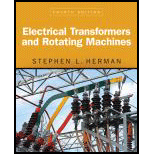Solutions for Electrical Transformers and Rotating Machines
Problem 2RQ:
What were early natural magnets known as?
Problem 3RQ:
The south pole of one magnet is brought close to the south pole of another magnet. Will the magnets...Problem 4RQ:
How can the polarity of an electromagnet be determined if the direction of current flow is known?
Problem 5RQ:
Define the following terms:
Flux density
Permeability
Reluctance
Saturation
Coercive force
Residual...Problem 6RQ:
A force of 1 ounce is equal to how many dynes?Browse All Chapters of This Textbook
Chapter 1 - MagnetismChapter 2 - Magnetic InductionChapter 3 - Inductance In Alternating-current CircuitsChapter 4 - Single-phase Isolation TransformersChapter 5 - AutotransformersChapter 6 - Current TransformersChapter 7 - Three-phase CircuitsChapter 8 - Three-phase TransformersChapter 9 - Single-phase Loads For Three-phase TransformersChapter 10 - Transformer Installation
Chapter 11 - Transformer CoolingChapter 12 - Transformer MaintenanceChapter 13 - HarmonicsChapter 14 - Direct Current GeneratorsChapter 15 - Direct Current MotorsChapter 16 - AlternatorsChapter 17 - Three-phase MotorsChapter 18 - Single-phase MotorsChapter 19 - Motor Maintenance And TroubleshootingChapter 20 - Motor Nameplate DataChapter 21 - Motor Installation
Book Details
Written specifically for future electricians, ELECTRICAL TRANSFORMERS AND ROTATING MACHINES, 4e delivers comprehensive coverage that reflects real-world practice. Extremely student friendly, the book uses common language in a format that is easy to understand. Offering the ideal blend of theory and hands-on applications, it integrates experiments throughout -- enabling you to put what you learn into practice. In addition, insightful schematics and illustrations ensure your thorough understanding of key concepts.
Sample Solutions for this Textbook
We offer sample solutions for Electrical Transformers and Rotating Machines homework problems. See examples below:
Chapter 1, Problem 1RQChapter 2, Problem 1RQChapter 3, Problem 1RQChapter 4, Problem 1RQThe given values are shown in below table: PrimarySecondary 1Secondary 2Secondary...The given values are shown in below table: PrimarySecondary 1Secondary 2Secondary...Chapter 5, Problem 1RQGiven: The number of turns between the windings A−B (NA−B) is 120. The number of turns between the...The differences in the connection between the primary winding of the voltage transformer and primary...
Given: The number of phases of the system (n) is 3. Calculation: The below figure represents the...The given values are shown in below table: Alternator (A)Load 1 (L1)Load 2 (L2)Load 2 (L2)EP(A)...Chapter 8, Problem 1RQThe given values are shown in below table: Primary (P)Secondary (S)Load (L)EP(P) EP(S) EP(L) IP(P)...Chapter 9, Problem 1RQGiven: The secondary voltage (V) is 240 V. The rating of the transformer (VA) is 15 kVA. The...Chapter 11, Problem 1RQChapter 12, Problem 1RQThe harmonics in an electrical system refers to the current and the voltage at a frequency is the...A device that converts the mechanical energy into electrical energy is called as generator. The...DC motor is a device that is used to convert direct current electrical energy into mechanical...Chapter 16, Problem 1RQThe three basic types of three-phase motors are as mentioned below. 1. Synchronous motors: The AC...A split phase motor is a type of induction motor which contains a single cage rotor. The two...Chapter 19, Problem 1RQThe National Electrical Manufacturers Association defines some basic parameters regarding the design...Given: The power of the motor (P) is 20 hp. The voltage applied to the motor (V) is 500 V....Given: Horsepower of the motor (P) is 75 hp. Line voltage (V) is 230 V. Power factor (F) is 80%....
More Editions of This Book
Corresponding editions of this textbook are also available below:
Related Mechanical Engineering Textbooks with Solutions
Still sussing out bartleby
Check out a sample textbook solution.
